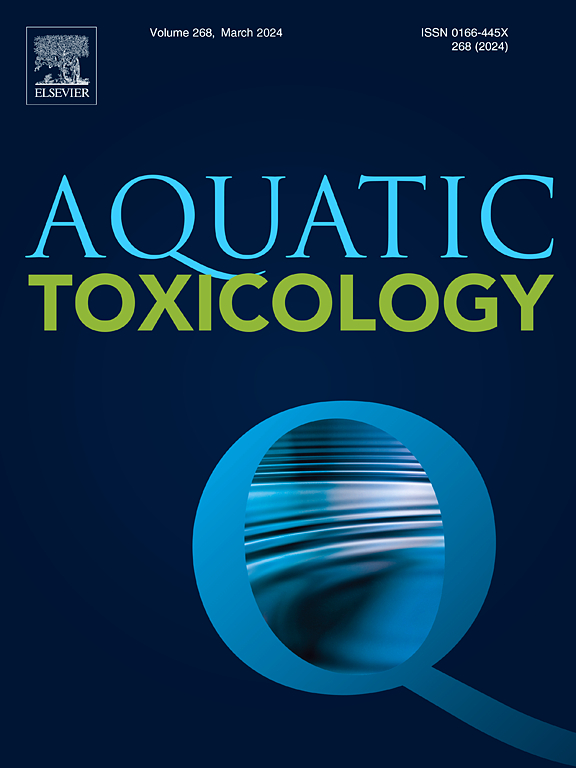Deleterious effects of in vivo parameters and oxidative stress-mediated autophagy and apoptosis induction via MAPKs and AMPK signaling pathways in the ammonia-exposed marine rotifer Brachionus plicatilis
IF 4.3
2区 环境科学与生态学
Q1 MARINE & FRESHWATER BIOLOGY
引用次数: 0
Abstract
In this study, we investigated the molecular mechanisms responsible for the physiological and behavioral consequences of ammonia exposure in the marine rotifer Brachionus plicatilis, a representative model of aquatic invertebrates. B. plicatilis is particularly susceptible to ammonia, which can induce substantial increases in antioxidant enzyme activities, including those of superoxide dismutase and catalase, along with reactive oxygen species. Furthermore, the expression of mitogen-activated protein kinases (MAPKs), a critical pathway implicated in oxidative stress, was investigated using western blots to elucidate increases in the phosphorylation of p38 among MAPKs. We also identified an adverse behavioral effect of ammonia exposure in the form of a reduction in swimming speed in B. plicatilis. Following this, the activity of acetylcholinesterase and expression of 5ʹ-adenosine monophosphate-activated protein kinase (AMPK) proteins were investigated to determine the relationship between deleterious behavioral effects and molecular responses. Western blots were also used to identify autophagy and apoptosis as molecular side effects of ammonia exposure in rotifers. Increased expression of relevant biomarkers indicated that autophagy and apoptosis occurred along with increased phosphorylation of p38 and AMPK among MAPKs. This study offers a deeper understanding of the impact of ammonia on marine organisms by investigating alterations at the molecular level, as well as physiological changes and behavioral patterns of rotifers in response to varying concentrations of ammonia.
在氨暴露的海洋轮虫中,体内参数和氧化应激通过MAPKs和AMPK信号通路介导的自噬和凋亡诱导的有害影响
在这项研究中,我们研究了氨暴露对水生无脊椎动物代表性模型——海洋轮虫(Brachionus plicatilis)生理和行为影响的分子机制。柔韧臂尾轮虫对氨气特别敏感,氨气可以诱导其抗氧化酶活性大幅增加,包括超氧化物歧化酶和过氧化氢酶的活性,以及活性氧。此外,利用western blots研究了丝裂原活化蛋白激酶(MAPKs)的表达,以阐明MAPKs中p38磷酸化的增加。MAPKs是涉及氧化应激的关键途径。我们还确定了氨暴露的不良行为影响,其形式是游泳速度的降低。随后,研究了乙酰胆碱酯酶活性和5′-腺苷单磷酸活化蛋白激酶(AMPK)蛋白的表达,以确定有害行为效应与分子反应之间的关系。Western blots还用于鉴定轮虫自噬和细胞凋亡作为氨暴露的分子副作用。相关生物标志物的表达增加表明,随着MAPKs中p38和AMPK磷酸化的增加,自噬和凋亡发生。本研究通过在分子水平上研究氨对海洋生物的影响,以及轮虫对不同浓度氨的生理变化和行为模式的反应,从而更深入地了解氨对海洋生物的影响。
本文章由计算机程序翻译,如有差异,请以英文原文为准。
求助全文
约1分钟内获得全文
求助全文
来源期刊

Aquatic Toxicology
环境科学-毒理学
CiteScore
7.10
自引率
4.40%
发文量
250
审稿时长
56 days
期刊介绍:
Aquatic Toxicology publishes significant contributions that increase the understanding of the impact of harmful substances (including natural and synthetic chemicals) on aquatic organisms and ecosystems.
Aquatic Toxicology considers both laboratory and field studies with a focus on marine/ freshwater environments. We strive to attract high quality original scientific papers, critical reviews and expert opinion papers in the following areas: Effects of harmful substances on molecular, cellular, sub-organismal, organismal, population, community, and ecosystem level; Toxic Mechanisms; Genetic disturbances, transgenerational effects, behavioral and adaptive responses; Impacts of harmful substances on structure, function of and services provided by aquatic ecosystems; Mixture toxicity assessment; Statistical approaches to predict exposure to and hazards of contaminants
The journal also considers manuscripts in other areas, such as the development of innovative concepts, approaches, and methodologies, which promote the wider application of toxicological datasets to the protection of aquatic environments and inform ecological risk assessments and decision making by relevant authorities.
 求助内容:
求助内容: 应助结果提醒方式:
应助结果提醒方式:


